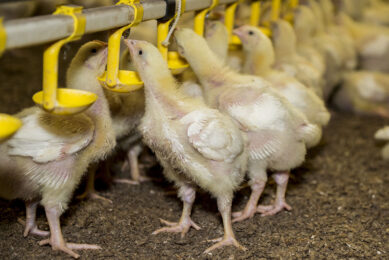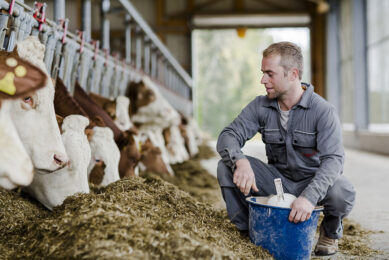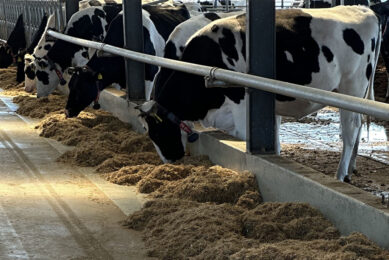Using nature to tackle heat stress

The Dutch initiative Trees for Cows has planted over 114,000 trees since the year 2000. Their long term goal is to create many cool and shady places in and along pastures for dairy cows to find shade during extreme temperatures. The initiative urges livestock farmers to start planting trees now to profit from them later.
Shade for livestock during warm, sunny days has always been important worldwide, but with global warming it’s becoming even more important. However, with increasing farm sizes and economy of scale, the number of trees in pastures has declined. They seemed to just get in the way of the tractors and harvesters which are getting bigger and bigger.
Disappearing trees
“Half a century ago, fields in Europe were scattered with trees and shady spots,” says Thomas van Slobbe, coordinator of Trees for Cows. “Since then, many trees have been cut down, partly due to land consolidation and scaling-up.
In Africa, trees are disappearing as a result of the drought and the use of trees as fuel.”
Tree planting schemes
But in recent years, trees have gained new, positive attention for 2 reasons. Increasingly hot summers on the one hand and the fact that trees bind CO2 on the other. This has led to tree planting schemes as trees provide shade and reduce the amount of greenhouse gas into the atmosphere. Van Slobbe oversaw the planting of more than 114,000 trees, planted along pastures in the Netherlands since the year 2000. Van Slobbe: “This was done with the support of several organisations, from environmentalists to farmers. Now the cows can seek out a cool spot in the shade during very hot spells. Also, every year a few thousand trees are added to our total.”
Temperature Humidity Index (THI)
Where in the world is heat stress most pressing and to what degree of heat stress the cows encounter, depends on various factors, according to Van Slobbe; “It is not possible to compare heat stress per country. Because In addition to temperature and humidity, high performing animals suffer more from heat than less productive cows, as with the effort to produce, the animal generates heat. Another factor is that some cow breeds can handle the heat better than others,” says Van Slobbe. A black cowhide absorbs more heat than a white cowhide. And the question of whether there is sufficient drinking water available, of course also has an influence.
Dutch farmers union LTO developed a Temperature Humidity Index (THI) in June 2020 and has since then been promoting it among its stakeholders in the livestock industry. With the THI, temperature and humidity are combined to a critical value, a parameter of the heat stress experienced by animals. The first THI studies were conducted in the 1950s at the American University of Missouri. With the THI, farmers can anticipate the effects of hot weather better. Van Slobbe: “LTO has now worked out a number of tips and tricks to mitigate heat stress and made them available for their stakeholders. It is clear that some of their tips can be applied in other countries as well. For example, letting the cows walk in the pastures at night and during the day, if it is too hot, allowing the cows to stay in the cool barns.”
Reasons to plant trees
Van Slobbe sees the planting of trees as part of the solution and he doesn’t stand alone in this. “Here in the Netherlands, we explicitly make the choice to plant trees to use as shade for the cows. In many other countries this is done implicitly, as a ‘logical’ consideration for example, for making the landscape more pleasant, ensuring sufficient firewood, binding CO2, etc. For me it is common sense to plant trees.”
Cows suffer more from heat than humans
According to the coordinator, cows thrive best at temperatures from -5°C to 15°C. They suffer more from heat than humans and that is often underestimated. The Netherlands has 1.6 million dairy cows. Last year, 83% of dairy farmers let their cows graze outside. Van Slobbe: “Since the Dutch livestock farming sector agreed in 2012 to encourage outdoor grazing, the percentage has never been as high as in 2019.”
Older cows need sufficient shade
According to Van Slobbe, it is especially important that older cows have a sufficient amount of shade, as they are more susceptible to heat stress. “Older cows do indeed suffer more from heat. Heifers that do not yet produce milk experience the least amount of problems. Seeing the trend of keeping cows outside, we know we cannot oppose that, even if it would make sense to keep the animals in a well ventilated barn during extreme heat spells. Instead we rather argue for an animal-friendly landscape with sufficient resting and shaded areas.”
Use native species
Trees for Cows mainly plants native tree species that fit well into the Dutch landscape. Van Slobbe: “The work on location is customised. Trees and shrubs are of native origin and they must fit into the landscape, which differs throughout our small country. We also ensures that there is a good balance between the number of trees and the number of cows per location. Furthermore, the planting is in or along pastures in such a way that the trees provide good shade for grazing livestock.” The types of ornamental shrubs and trees that are used are diverse from Apple, Bitter Willow, Forest Willow, Common Hawthorn to Wild Apple, Sweet Cherry, Pedunculate Oak and Black Alder.
Start planting trees in time
Another point to keep in mind is that you have to be patient when planting trees, according to Van Slobbe. “It does not offer an immediate solution, trees need time to grow and to gain sufficient size. It will therefore take a few years for the planted trees to be large enough to provide substantial shade. And trees also bind more CO2 when they are bigger. That is why you cannot start planting quick enough,” the coordinator concludes.
 Beheer
Beheer





 WP Admin
WP Admin  Bewerk bericht
Bewerk bericht